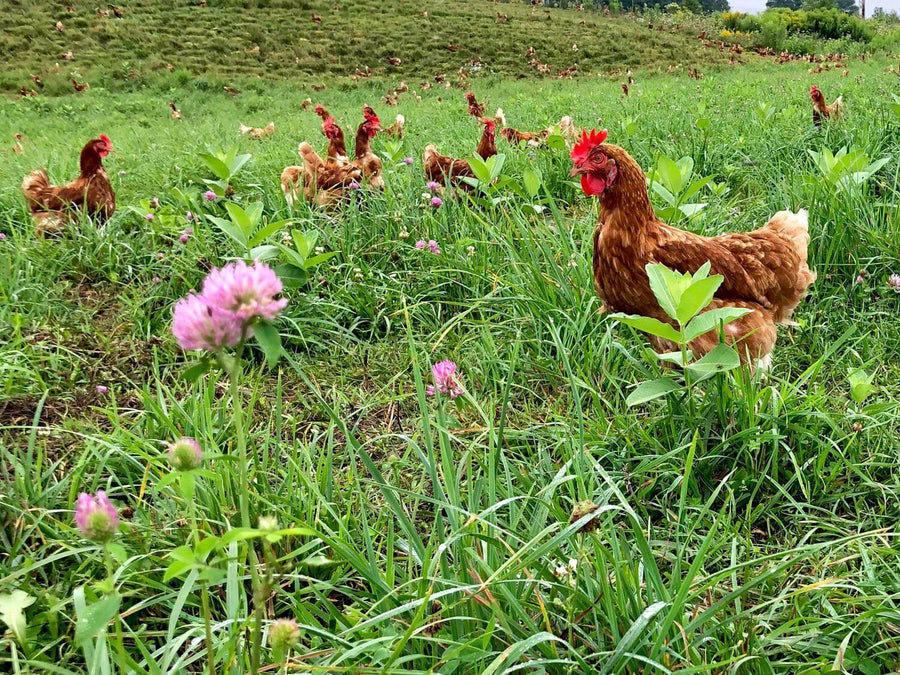
Understanding the Difference Between Free-Range and Cage-Free
Decoding the egg aisle is no easy task for the average grocery shopper. And that’s because in this day and age, the proliferation of misleading and meaningless words and seals that make a carton stand out in a vast sea of egg options has become the norm. For those of us at Pete & Gerry's, empty terms like “farm fresh” and “all natural” are on the same plane as “cage-free.” So what’s wrong with cage-free? Why is the diminishing role of cages in the egg industry a bad thing? We’re here to spell out the difference between cage-free and free-range eggs, and why this difference should matter to you when you’re faced with making a decision at the grocery store.
What does cage-free mean?
The term “cage-free” has become a buzzword in the egg industry. And like most buzzwords, it’s not all it’s cracked up to be. In the case of egg-laying hens, cage-free is regulated by the USDA, but remains an incredibly vague term: the USDA doesn’t offer any specifications for space allotted to each hen, and doesn’t include any requirements for access to natural sunlight via windows or other types of openings. Cage-free hens have the ability to move vertically (to an extent, especially in factory-like cage-free warehouses with multiple levels) and horizontally in their indoor living spaces. According to an independent committee assembled by United Egg Producers, 95% of all U.S. egg production came from caged hens in 1995. And although that number is on the decline today with the popularity of cage-free egg production on the rise, the lack of outdoor access and cramped conditions found on many cage-free factory farms makes the term itself much less positive and consequential than it sounds. In short, when you see the cage-free label in the egg aisle, here’s what it might mean for the hens that laid those eggs:
- No outdoor access
- Little to no space to stretch, dust bathe, or perch
- No access to natural sunlight
- Exposure to disease and unclean, overcrowded facilities
What does free-range mean?
So, what does free-range really mean? The term “free-range” is federally regulated, but due to the USDA’s lack of detailed guidelines, third party certifiers are the gold standard when it comes to free-range eggs. Without a strong third party certifier to back free-range claims, these hens can be confined to screened-in porches or cement and still be considered free range. All Pete & Gerry’s partner farmers follow the Humane Farm Animal Care (HFAC) Certified Humane Pasture-Raised or Free-Range standards, which are arguably the highest and most transparent of their kind. On our farms, this means that during most times of the day and year (except during inclement weather and when predators are spotted in the area), our hens are free to roam outside as they please.
How much space do free-range hens have?
Our Pete & Gerry's free-range flocks enjoy a minimum of 2 square feet per hen of outdoor pasture—and that’s an average for every hen in the flock. It's very rare for the entire flock to choose to be outside at any one time during the day; most of them prefer the shade, water, feed, or social opportunities inside the barn, so the girls that feel like venturing out usually have a vast expanse of a field all to themselves to explore. When you pick up a carton of Pete & Gerry's Eggs, know that the hens that laid them enjoyed:
- Daily access to green, grassy pastures that are never treated with synthetic pesticides
- Absolutely no cages
- Freedom to stretch, dust bathe, perch, and lay in privacy
- Daily access to clean, fresh water and organic feed
- Outdoor shade structures
- A minimum of 2 square feet per hen
What's the difference between cage-free and free-range eggs?
The most significant difference between eggs from cage-free and free-range hens is outdoor access. Put simply, free-range hens have it, while cage-free hens don’t. But with outdoor access come so many other benefits to hens—most notably, the ability to display their natural behaviors.
| Cage-Free Farms | Pete & Gerry's Farms |
|---|---|
| - Unregulated | - Balanced, nutritious supplemental feed |
| - No outdoor access | - Certified Humane standards |
| - No natural light | - Easy pasture access and outdoor shade structures |
| - Caged enclosures | - No cages |
| - Factory farms | - Spacious, single-level barns |
What about pasture-raised?
Generally speaking, pasture-raised eggs come from hens given ample access to outdoor pasture. Our pasture-raised flocks roam on expansive green pastures with 108 square feet of outdoor space per hen, allowing hens to forage, explore, and socialize with friends. Both free-range and pasture-raised eggs meet high animal welfare standards as they allow laying hens ample access to outdoor pasture and fresh sunshine.
Isn't cage-free a step in the right direction?
In recent years, state-level initiatives like California’s Proposition 12 have called for new standards related to confinement, particularly in the case of egg-laying hens. Having produced to Certified Humane standards since 2003, we think this is a step in the right direction and long overdue. But we also want consumers to understand that while cage-free is an improvement, many cage-free facilities still consist of floor to ceiling enclosures and massive warehouse barns that provide no outdoor access for laying hens. As advocates for real change, we think it's time to push for healthy free-range and pasture-raised standards nationwide rather than giving factory farms more protection under another far-from-perfect label.
Sustainable egg choices
When considering sustainable egg choices, it's important to understand the impact of your purchase on both the environment and animal welfare. Free-range and pasture-raised eggs not only support better living conditions for hens but also promote sustainability.
By choosing eggs from farms that prioritize outdoor access and humane treatment, you are contributing to a more sustainable, ethical food system. In the end, sustainable egg choices are about more than just the label — they're about ensuring that the practices behind the production of those eggs are socially responsible.




